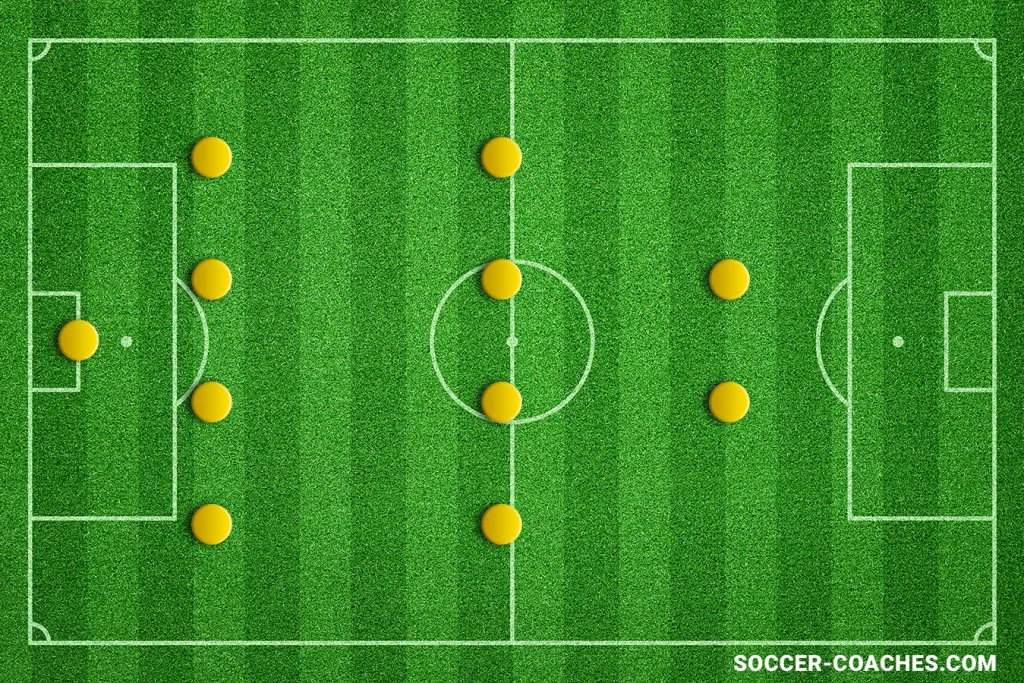No soccer team can be effortlessly molded into a random tactical system, and no formation is inherently superior. The real question is: Which players do you have – and how can you maximize their strengths? Yet, in reality, tactical identity is not shaped by players alone.
Coaches often bring a defined style of play and reshape squads to match their principles, while some clubs with long-standing traditions hire coaches who fit their philosophy instead of the other way around. Ajax Amsterdam is the textbook case: their 4-3-3 framework, rooted in Rinus Michels’ and Johan Cruyff’s “Total Football,” has become inseparable from the club’s DNA. Every generation — from Michels and Van Gaal to Erik ten Hag — inherits a system centered on positional play, fluid interchange, and attacking with width.

But this kind of alignment between philosophy and personnel usually happens in environments with resources, patience, and long-term planning — clubs with academies, scouting systems, and budgets built to support one tactical identity.
Outside of those elite setups, most coaches find themselves in a very different reality: they have to work with what they have. In lower divisions or resource-limited teams, recruitment is rarely ideal, training facilities are shared, and squad turnover can be unpredictable. Here, tactical flexibility and adaptability become the coach’s most valuable tools.
Every formation decision must emerge from existing strengths, not theoretical principles, because survival and competitiveness depend on making the most out of limited player profiles and training conditions.
System Selection Begins with Squad Analysis
Choosing a tactical system is always a matter of squad composition. If your midfield is stacked with physically strong, defensively solid players, a classic 4-4-2 can offer the necessary stability. Center-backs who dominate aerial duels and maintain defensive structure provide the backbone, while attack-minded full-backs can initiate counterattacks and apply pressure on the flanks. This is where player profiles shape the entire tactical framework.

On the other hand, if your squad is rich in creativity and technical skill, a 4-2-3-1 unlocks offensive potential. Coaches with dribblers and playmakers benefit from a wide attacking line that stretches defensive blocks and creates unpredictability through dynamic movement. This setup suits clubs like Bayern Munich or Manchester City, where attacking midfielders thrive in one-on-one situations and operate fluidly between the lines.
If wing play is your strategic focus, a 3-4-3 becomes a powerful option—provided you have wingbacks with stamina and technical quality. These players must secure the flanks defensively while also driving deep into attacking zones. Teams like Bayer Leverkusen (with Jeremie Frimpong) or Chelsea (with Reece James) exploit this dynamic, knowing that a 3-4-3 only works with players who can consistently push the tempo and open up the game.
From Theory to Practice: It Starts with the Players
Every tactical decision must begin with a clear analysis of your squad. Technical ability, creativity, physicality, speed, and even mental attributes and leadership qualities determine which system will truly work. Today’s clubs rely on data tools, performance profiles, and GPS tracking to define roles and optimize formations. Knowing your player types allows you to justify every tactical shift.
Success doesn’t come from copying trendy formations—it comes from adapting systems to fit your squad. Tactical setups are only as effective as the players who bring them to life with their personality and strengths. Once roles are clearly defined and key players are used optimally, theory becomes practice—regardless of buzzwords or tactical fads.

Key Question for Coaches: What Defines Your Squad?
If your center-backs are defensively strong and dominant in the air, a compact system like the 4-4-2 with clear role distribution is ideal. Wingers should be able to track back and cover ground, while strikers press aggressively and seek finishing opportunities.
If your squad features technically gifted, creative players, the 4-2-3-1 offers flexibility and attacking power. The central attacking midfield role suits playmakers and dribblers, while the wings are best filled by fast, risk-taking attackers.
If your team is built around energetic, versatile wide players, the 3-4-3 maximizes wingback dynamism and offensive fluidity.
Formation Profiles: What Each System Demands
4-4-2
- Center-backs: Toughness, aerial strength, tackling
- Full-backs: Defensive reliability, crossing ability, transition play
- Central midfielders: Box-to-box stamina, physical presence
- Strikers: Pressing, target play, finishing
4-2-3-1
- Center-backs: Build-up play, anticipation
- Double pivot (CDMs): Defensive coverage, playmaking
- Attacking midfielders: Creativity, pace, dribbling
- Wingers: Breakthrough ability, goal threat
- Striker: Target man, deep runs
3-4-3
- Back three: Flexibility, ball control, width coverage
- Wingbacks: Stamina, crossing, endurance
- Central midfielders: Game organization, spatial awareness
- Front three: Creativity, mobility, finishing
Real-World Examples
- Atlético Madrid uses a compact 4-4-2 to leverage its physical squad and defensive discipline.
- Bayern Munich thrives in a 4-2-3-1, utilizing playmakers and fast wingers for creative breakthroughs and counterattacks.
- Bayer Leverkusen adapts a 3-4-3 to integrate dynamic wingbacks and offensive individualists, switching fluidly between possession and transition play.
Coaching Takeaway: Build from the Player Up
To coach effectively, start with a deep understanding of your players’ technical, physical, and mental traits:
- Who are your key players and what are their personalities?
- Which roles inspire motivation and performance in matches and training?
- How can you use data (GPS, video analysis) to uncover weaknesses or untapped potential?
Great coaches don’t impose structure—they reveal potential. The best tactical systems are flexible blueprints shaped by the squad’s strengths. Once a coach understands the human side of the game—personalities, instincts, and chemistry—formation becomes just a tool.
Ultimately, it’s not the system that makes the difference—it’s the players, and how well their profiles align with your strategy.
Tactical Games – Part 2

50 numbers-up games from 1v1 to 4v4
Position games with neutral players from 1 against 1 to 4 against 4, vary the number of “Jokers” and their position inside and outside the field. Help the players getting as many chances to score and then use them perfectly.

